Sherwin-Williams Extra White (SW 7006): The Ultimate Guide to This Crisp White Paint
Navigating the vast world of white paint colors can often feel overwhelming, with countless shades and subtle nuances that make choosing the “perfect” one a significant challenge. However, for many homeowners and designers, Sherwin-Williams Extra White (SW 7006) emerges as a clear frontrunner. Renowned for its clean, crisp finish, this particular shade offers a bright, modern aesthetic that effortlessly elevates a diverse range of interior and exterior spaces.
Whether you’re looking to refresh your trim and ceilings, create a vibrant backdrop for your walls, or achieve a cohesive look throughout your entire home, Extra White stands out for its exceptional versatility and undeniably fresh vibe. Its ability to brighten rooms and provide a neutral yet distinct foundation makes it a go-to choice for a multitude of design styles.
In this comprehensive guide, we will delve into the essential characteristics of Sherwin-Williams Extra White. We’ll explore how its unique undertones manifest in different rooms and under varying lighting conditions, providing you with a clear understanding of what to expect. Furthermore, we’ll offer a detailed comparison of Extra White against other popular Sherwin-Williams whites, helping you discern its subtle differences and make an informed decision for your next painting project. If you’re undertaking a minor refresh or a full-scale renovation, you might discover that Extra White is precisely the shade you need to achieve your desired aesthetic.
Discovering Sherwin-Williams Extra White (SW 7006)

Sherwin-Williams Extra White (SW 7006) is a quintessential bright, crisp white paint color, consistently described as clean, pure, and incredibly fresh. It holds a prominent position as a top choice for both interior and exterior applications, providing a sophisticated and polished foundation that effortlessly complements modern design aesthetics and creates a luminous atmosphere in any setting.
Basic Color Profile and Key Characteristics
- HEX code: #EEEFEA
- LRV (Light Reflectance Value): 86
- Color family: Stark white with subtle blue-gray undertones
This remarkable color is an integral part of Sherwin-Williams’ Whites and Pastels collection. Its impressive Light Reflectance Value (LRV) of 86 signifies its exceptional ability to reflect light, making it an ideal candidate for brightening spaces, making rooms feel larger, and enhancing the vibrancy of other colors in your decor. An LRV of 86 places Extra White firmly in the high-reflectance category, meaning it will contribute significantly to the overall brightness and airiness of any room it graces.
Extra White resides comfortably within the cooler white spectrum. This characteristic is precisely what imparts a clean, crisp, and almost gallery-like feel to your space without ever appearing overly sterile or stark. Its cool nature makes it particularly well-suited for contemporary or minimalist settings, as well as in any area where the objective is to maximize light and create an open, expansive ambiance. It provides a stark yet inviting backdrop that allows furnishings and artwork to truly pop.
Understanding Extra White’s Subtle Undertones
One of the most defining aspects of Extra White is its intriguing blue-gray undertones. While subtle, these undertones are crucial to the paint’s character and can become quite noticeable, depending heavily on the specific lighting conditions within your room. These delicate cool undertones are what prevent Extra White from appearing flat or one-dimensional, instead lending it a desirable depth and sophisticated nuance.
- In abundant daylight, particularly in rooms blessed with ample natural light, you will likely observe the distinct presence of the blue undertones. This effect enhances the crispness of the white, giving it a refreshing and invigorating quality.
- Conversely, under warmer artificial light sources, such as incandescent bulbs or warm-toned LED lighting, the gray undertones tend to become more apparent. This can soften the paint’s appearance, offering a refined and slightly more muted look compared to its daytime brilliance.
This fascinating shifting effect of its undertones is precisely what contributes to Extra White’s reputation as an incredibly versatile color. It adapts to its environment, offering a dynamic white that can feel both cool and inviting. However, due to this sensitivity to light, it is absolutely essential to test the color directly in your specific space. By applying a sample swatch on multiple walls and observing it at various times of day, you can fully understand how Extra White interacts with your unique lighting and existing elements before committing to a full application.
Sherwin-Williams Extra White (SW 7006) in Real Spaces
The beauty of Extra White lies in its chameleon-like ability to adapt and present itself uniquely in different environments. Its appearance can shift significantly based on the room’s function, existing decor, and, most importantly, the lighting conditions. Here’s a closer look at how SW Extra White typically performs in various areas of a home, helping you determine if it’s the ideal choice for your project.
How It Looks in Different Rooms
Kitchens: A Foundation of Freshness
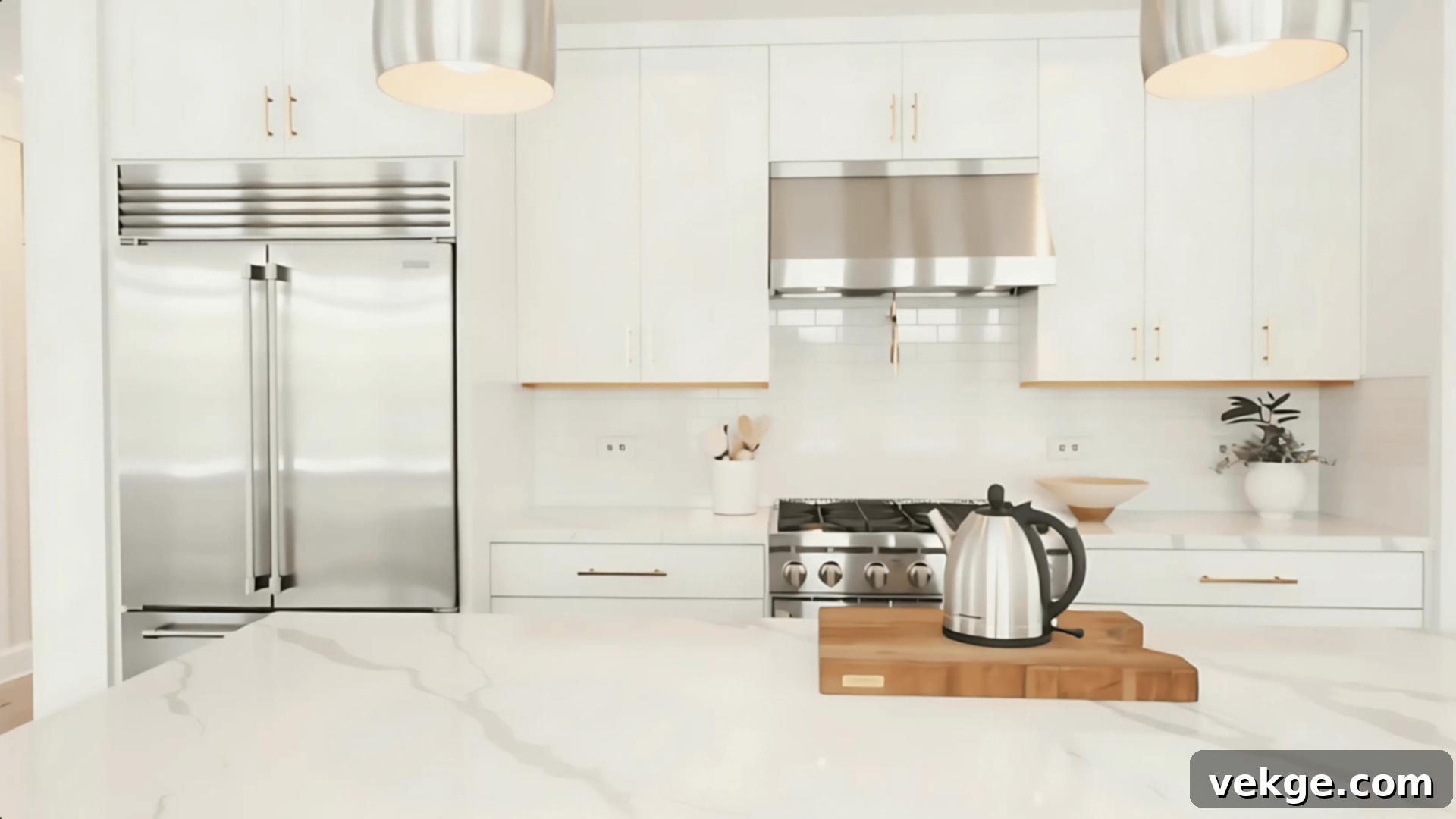
In kitchens, Extra White truly shines, providing an impeccably bright and crisp base that evokes cleanliness and modernity. It forms an exquisite pairing with classic white cabinets, offering a seamless and unified look. Its cool undertones beautifully complement the sleekness of stainless steel appliances, creating a cohesive and sophisticated aesthetic. Furthermore, when combined with natural wood accents like butcher block countertops or open shelving, Extra White provides a refreshing contrast that highlights the warmth of the wood without overwhelming it. The subtle cool undertones of Extra White adeptly balance out the warmer lighting often found in pendant or overhead kitchen fixtures, ensuring the space feels consistently clean, fresh, and inviting.
Bathrooms: Spa-Like Serenity
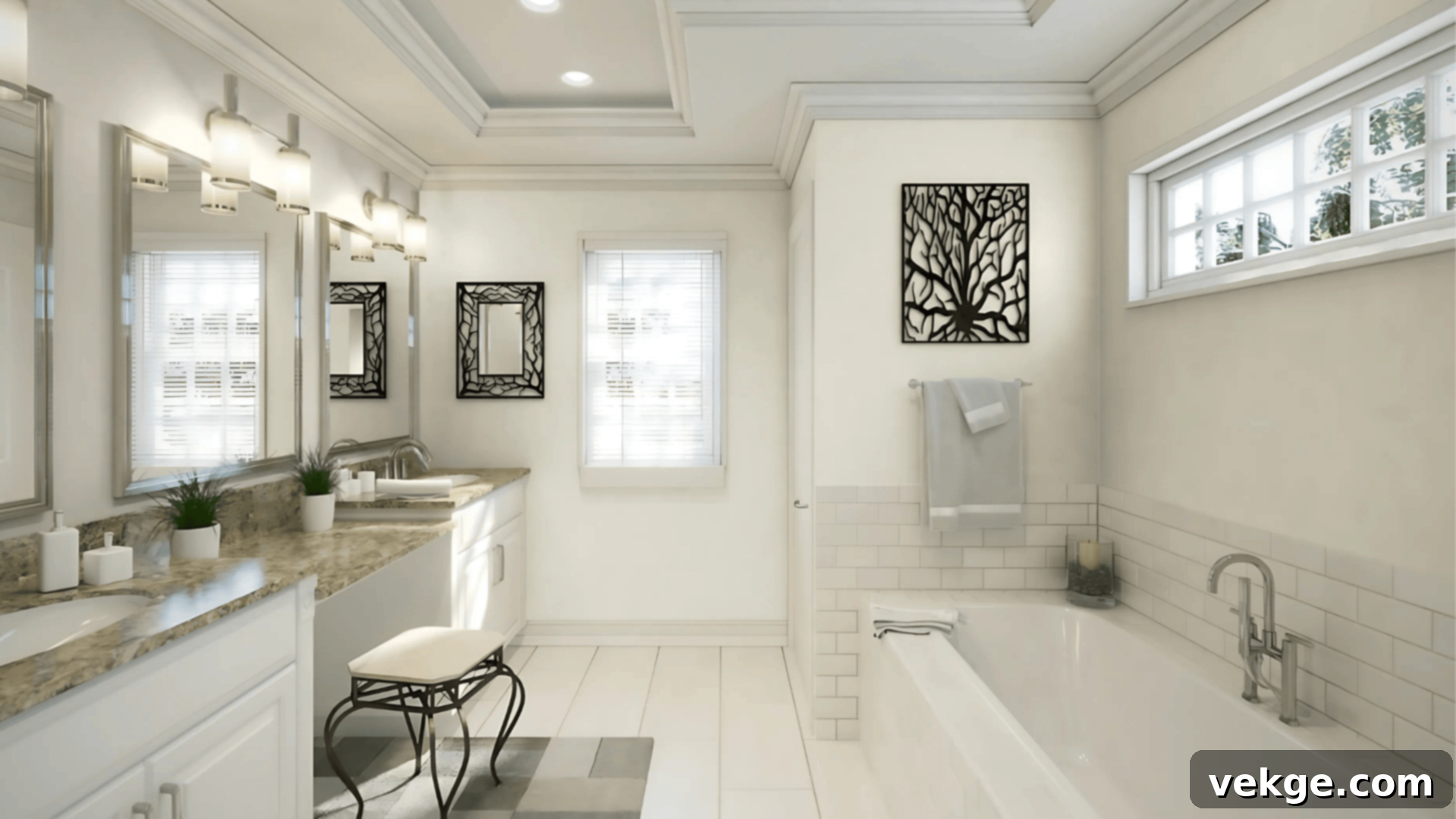
Bathrooms, by nature, demand a sense of cleanliness and calm, and Extra White delivers precisely that with its clean, airy, and refreshing vibe. It works harmoniously with white or marble tile, creating a luxurious and expansive feel that makes even smaller bathrooms appear more open and serene. Paired with polished chrome fixtures or minimalist decor, it enhances the spa-like ambiance. In more compact bathrooms with limited natural light, the inherent blue undertones of Extra White may become slightly more pronounced, contributing to a cool and invigorating atmosphere. Despite this, the color consistently remains bright and remarkably inviting, preventing the space from feeling cramped or dull.
Living Rooms: Effortless Elegance

For living rooms, Extra White introduces a wonderfully relaxed and airy feel that instantly makes the space feel larger and more welcoming. Its neutral yet distinct character means it beautifully complements both contemporary modern and classic traditional styles, offering a versatile backdrop that never overpowers other colors or design elements. This makes it an ideal canvas for showcasing vibrant artwork, rich textiles, or carefully curated furniture pieces. Extra White is absolutely perfect for cultivating a light, open, and sophisticated atmosphere, allowing for effortless decor changes over time without requiring a full repaint.
Bedrooms: A Haven of Calm

Transform your bedroom into a peaceful and luminous sanctuary with Extra White. This paint color fosters a sense of calm and openness, making it an excellent choice for creating a restful environment. It pairs exceptionally well with soft, layered bedding, whether in muted tones or rich textures, and complements various furniture styles, from warm wooden pieces to sleek metal frames. The cool cleanliness of Extra White contributes to a serene atmosphere, perfect for relaxation. As with any paint color, it’s crucial to be mindful of the direction your bedroom windows face, as this will significantly influence how the blue-gray undertones of Extra White subtly shift and appear throughout the day. It allows for a minimalist backdrop that can be easily customized with accent pillows, throws, and decor.
In essence, Sherwin-Williams Extra White truly excels in spaces where the goal is to establish a bright, fresh, and slightly cool backdrop, achieving a sophisticated look that avoids the sometimes overly stark appearance of a pure, unadulterated white. It’s an ideal choice for trim, ceilings, and walls alike, providing a consistent and appealing luminosity.
The Profound Impact of Lighting on Extra White
Understanding how light interacts with Extra White is paramount to predicting its final appearance in your home. Lighting is a dynamic factor, and the same paint color can exhibit significant tonal shifts depending on the quality, direction, and time of day, as well as the type of artificial lighting present.
- North-facing rooms: These rooms typically receive cooler, indirect light throughout the day. In such environments, Extra White’s inherent blue-gray undertones will likely be more prominent, causing the paint to appear noticeably cooler and crisper, sometimes leaning more towards a very soft pale blue or gray.
- South-facing rooms: Benefiting from abundant, warm, and bright natural light for much of the day, south-facing rooms tend to soften Extra White. The warmth of the light counteracts the paint’s cool undertones, often giving it a more neutral and balanced appearance, leaning closer to a true, pure white.
- East-facing rooms: Morning light in east-facing rooms is generally bright and cool. This specific lighting condition tends to accentuate Extra White’s crispness, making it feel particularly cool and clean during the early hours of the day. As the day progresses and the light shifts, the color will also evolve.
- West-facing rooms: In the evenings, west-facing rooms are bathed in warm, golden sunlight. This late-day warmth can beautifully highlight the subtle gray undertones within Extra White, lending it a softer, perhaps even slightly warmer, and more inviting look as the day draws to a close.
Beyond natural light, artificial lighting also plays a critical role. Cool-toned LED bulbs (5000K+) will emphasize the blue undertones, while warm-toned bulbs (2700K-3000K) will bring out the gray. Due to these continuous changes in light throughout the day, it is absolutely imperative to test a sample of Extra White on multiple walls in your chosen room. Observe how it looks during various times – morning, noon, and night – to fully grasp its dynamic behavior in your unique space. This step is invaluable for ensuring satisfaction with your final paint choice.
Choosing the Right Finish for Sherwin-Williams Extra White
The paint finish you select for Extra White can dramatically alter its visual appeal, durability, and how it interacts with light in your space. Each finish has distinct characteristics that make it suitable for particular applications. Here’s a detailed breakdown of common paint finishes and their optimal use with Extra White:
- Semi-Gloss: This highly durable finish is the quintessential choice for trim, doors, and moldings. Its pronounced sheen effectively reflects light, which makes Extra White appear even brighter and more luminous, especially in areas with natural light. Beyond aesthetics, semi-gloss is highly resistant to moisture, stains, and scuffs, making it easy to clean and maintain, perfect for high-traffic areas and creating a crisp contrast against walls.
- Satin: Offering a soft, subtle sheen that’s less reflective than semi-gloss but more than eggshell, satin is an ideal finish for interior walls and ceilings. With Extra White, satin provides a smooth, elegant, and clean finish without being overly glossy. It offers good durability and washability, making it a popular choice for busy areas like living rooms, bathrooms, and kitchens where occasional cleaning is necessary.
- High-Gloss: For those seeking a dramatic impact, high-gloss creates an exceptionally shiny, mirror-like surface. With Extra White, this finish makes the color stand out dramatically, reflecting light intensely. While stunning for accent walls, statement furniture pieces, or specific architectural details, it should be used sparingly in large areas. Its high reflectivity can emphasize imperfections, so a perfectly smooth surface is crucial.
- Flat/Matte: Characterized by having virtually no shine, a flat or matte finish provides a sophisticated, velvety, and understated look. It’s excellent for concealing minor surface imperfections, making it a superb choice for ceilings and low-traffic areas where a non-reflective, smooth aesthetic is preferred. With Extra White, a flat finish creates a soft, almost ethereal backdrop that absorbs light, contributing to a serene and calm atmosphere.
- Eggshell: Eggshell is a highly versatile finish that offers a slight, subtle sheen, reminiscent of an eggshell. It strikes an excellent balance between durability and a soft appearance. This finish works exceptionally well on walls throughout the home, including living rooms and bedrooms, providing enough reflectivity to brighten a space without being distracting. It’s more durable and easier to clean than flat paint, making it a practical choice for everyday living.
Each paint finish possesses unique strengths and advantages. When choosing, consider the specific function of the area, the level of durability and washability required, and the desired aesthetic interaction with light in your home. Thoughtful selection of the finish will significantly enhance the beauty and longevity of your Extra White paint job.
Extra White vs. Other Popular Sherwin-Williams Whites
Sherwin-Williams boasts an extensive palette of white paint colors, each with its own character and charm. Deciding which white is the perfect fit for your home can be a daunting task. To help clarify, here’s a detailed comparison of Extra White (SW 7006) against some of the brand’s most frequently chosen white shades, highlighting their key differences.
Extra White vs. High Reflective White (SW 7757)
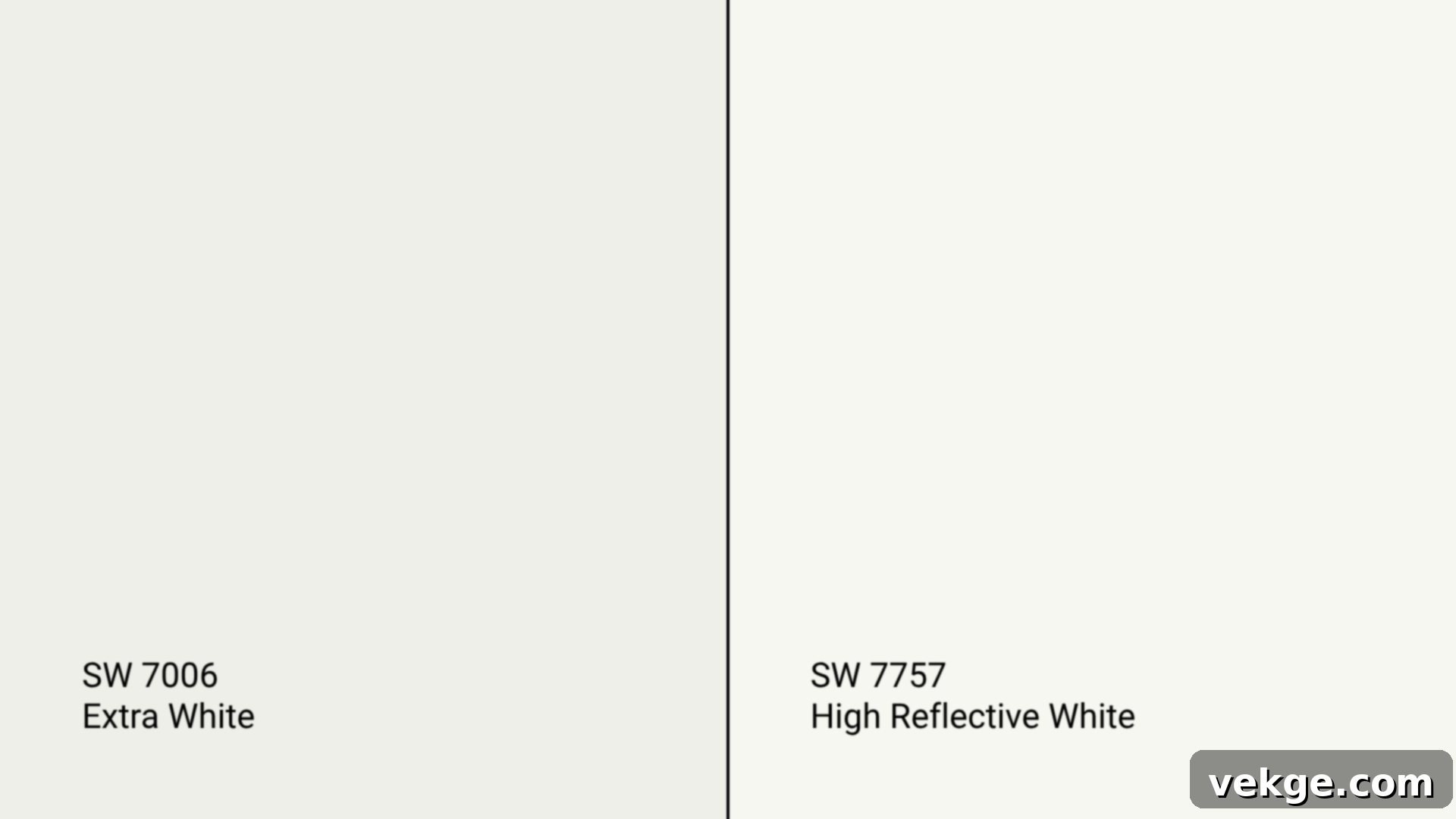
High Reflective White (SW 7757, #F7F7F1) is widely considered Sherwin-Williams’ absolute brightest and purest white, characterized by its almost imperceptible undertones.
- High Reflective White: This paint embodies pure, unadulterated white. With an outstanding LRV of 93, it reflects the maximum amount of light, making spaces feel incredibly expansive and brilliantly lit. It’s the ultimate choice for those seeking a stark, true white with virtually no discernible color bias.
- Extra White: While also very bright, Extra White maintains its distinct cool character with those subtle blue-gray undertones (LRV 86). It offers a clean, crisp look but with a touch more depth than the almost clinical purity of High Reflective White.
Recommendation: If your objective is the highest possible brightness and a genuinely pure white without any hint of color, High Reflective White is your ideal choice. However, if you desire a bright white that possesses a subtle cool depth to prevent it from appearing too stark or sterile, Extra White provides a more nuanced and defined option.
Extra White vs. Pure White (SW 7005)
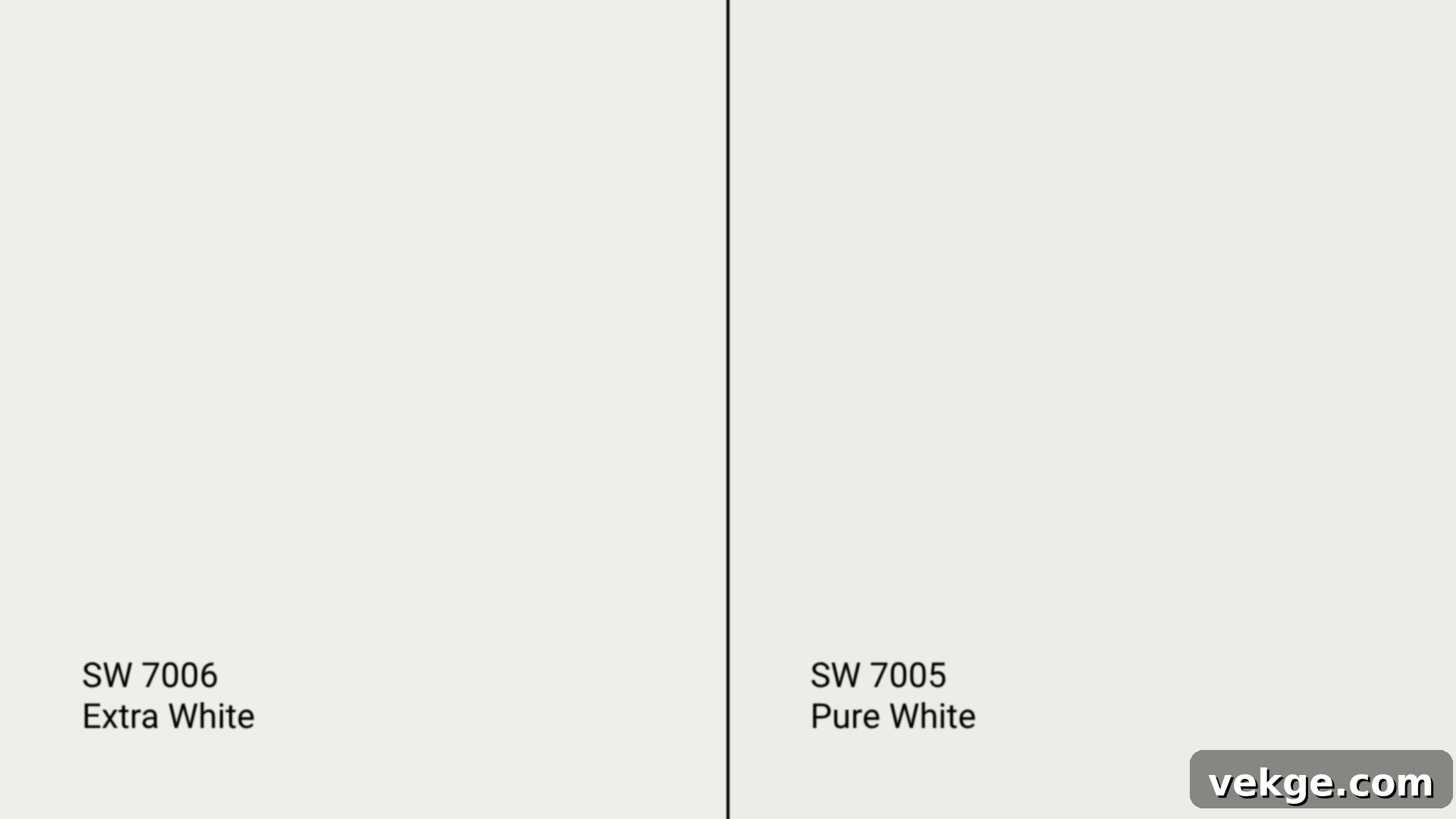
Pure White (SW 7005, #EDECE6) is cherished for being a soft, incredibly versatile neutral white, distinguished by its very subtle gray undertones that prevent it from appearing too harsh.
- Pure White: With an LRV of 84, Pure White leans slightly warmer and softer than Extra White. Its subtle gray undertone creates a welcoming, almost creamy feel without veering into yellow or beige territory, making it a highly adaptable choice for various styles.
- Extra White: Conversely, Extra White presents cooler, clearer tones, offering a brighter and sharper appearance (LRV 86). Its blue-gray undertones give it a more distinct, crisp edge compared to the softness of Pure White.
Recommendation: If your goal is to create a soft, inviting, and slightly warmer ambiance that still reads as white, Pure White is an excellent option. However, for a crisper, more modern, and noticeably brighter appearance with a hint of coolness, Extra White will be the better fit.
Extra White vs. White Sand (SW 9582)

White Sand (SW 9582, #EDECE7) is a soft, inviting off-white that carries a noticeable hint of beige, making it significantly warmer than Extra White.
- White Sand: With an LRV of 84, White Sand has a distinctly warmer, softer feel due to its delicate beige undertones. It creates a cozy and welcoming atmosphere, ideal for spaces that crave warmth and a subtle color presence rather than a pure white.
- Extra White: In stark contrast, Extra White maintains its cooler stance with its subtle blue-gray undertones (LRV 86). It offers a much crisper and brighter appearance, lacking the creamy or sandy warmth of White Sand.
Recommendation: If your space benefits from a touch of warmth, a cozy ambiance, and a soft, inviting undertone, White Sand is an excellent choice. However, for those aiming for a modern, crisp, and clean look with definite cool undertones, Extra White will achieve the desired effect.
Extra White vs. White Sail (SW 9622)
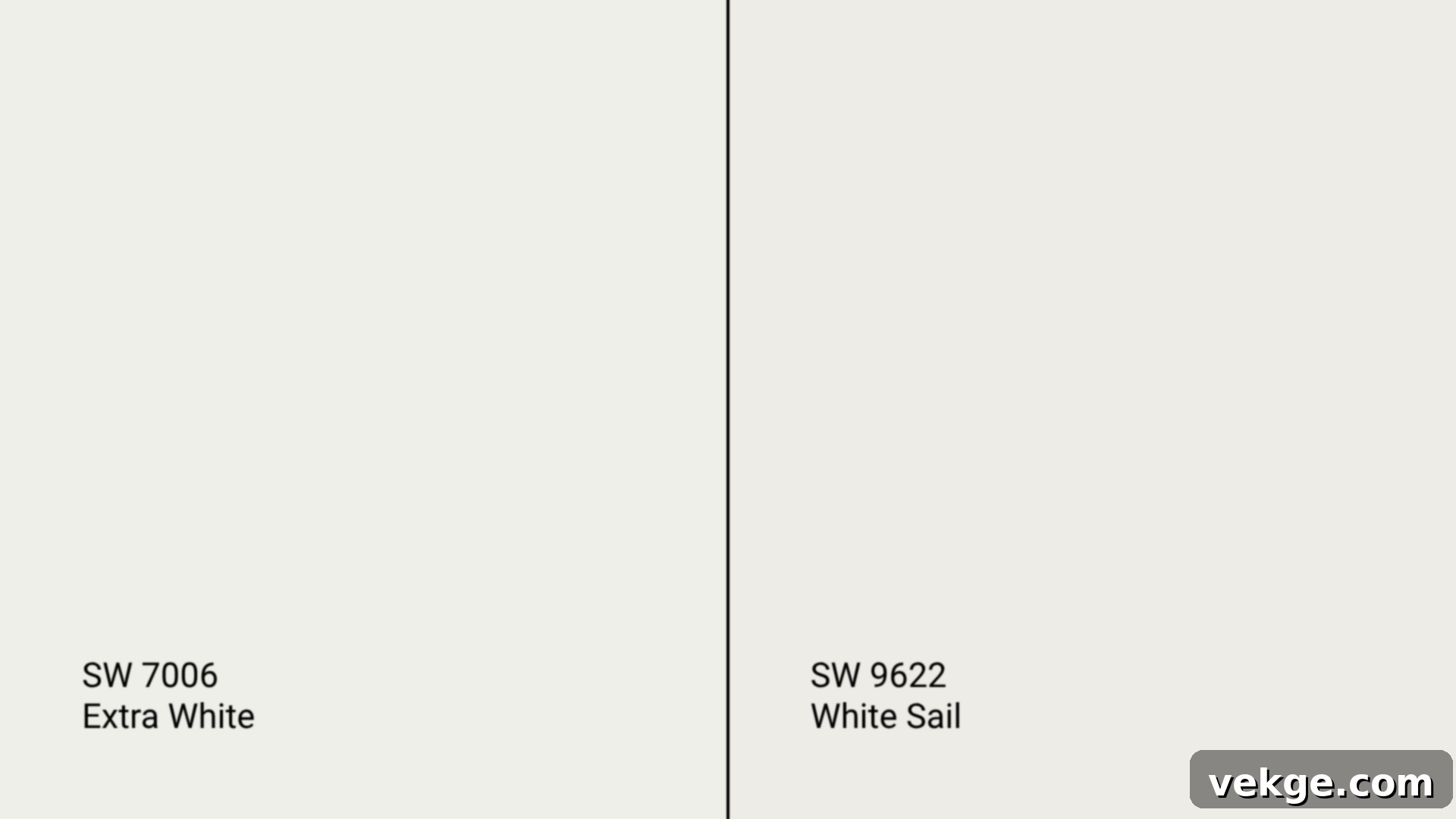
White Sail (SW 9622, #EBEBE7) can be described as a very light, almost ethereal gray that carries a delicate touch of warmth within its undertones, making it a softer alternative to stark whites.
- White Sail: With an LRV of 85, White Sail features soft gray and subtle beige undertones, which imbue it with a gentle warmth and a more muted, subtle feel. It functions beautifully as a very light neutral that provides a slightly cozy envelope without being overtly colored.
- Extra White: Maintaining its cool and more vibrant profile (LRV 86), Extra White consistently showcases its characteristic blue-gray undertones, providing a sharper contrast and a more defined bright white appearance compared to the softer White Sail.
Recommendation: For a warm, soft, and understated look that leans towards a very light greige, White Sail is an excellent option. However, if you are seeking a fresh, modern touch with distinctly cooler and brighter tones, Extra White is the preferred choice to achieve that crisp, clean aesthetic.
Extra White vs. Ceiling Bright White (SW 7007)

Ceiling Bright White (SW 7007, #E9EBE7) is specifically formulated for ceilings, designed to offer a soft, cloud-like white with a subtle hint of warmth.
- Ceiling Bright White: This color, with an LRV of 83, is distinctly warmer and softer, providing a gentle, diffused look that helps to recede ceilings and create a comforting canopy. It’s designed to be unassuming and broadly compatible with various wall colors.
- Extra White: With its LRV of 86, Extra White delivers a cleaner, cooler, and more vivid finish. While it can certainly be used on ceilings, its primary strength lies in creating crisp walls and sharp trim work, offering more definition than Ceiling Bright White.
Recommendation: If you’re looking for a subtle, softer white specifically for ceilings that won’t compete with your wall color, Ceiling Bright White is an excellent, purpose-designed choice. However, for a fresher, sharper, and more defined bright white that works beautifully on both walls and trim, Extra White is highly versatile and effective.
Undertone and LRV Comparison Table
| Paint Color | Undertones | LRV | Warm or Cool |
|---|---|---|---|
| Extra White (SW 7006) | Blue-gray | 86 | Cool |
| High Reflective White (SW 7757) | Minimal undertones | 93 | Cool |
| Pure White (SW 7005) | Subtle gray | 84 | Warm |
| White Sand (SW 9582) | Beige | 84 | Warm |
| White Sail (SW 9622) | Light gray, slight warmth | 85 | Warm |
| Ceiling Bright White (SW 7007) | Soft cloud-like | 83 | Warm |
These comparisons demonstrate that while all are “whites,” their undertones and LRVs cause them to behave quite distinctly. Each of these Sherwin-Williams whites is a fantastic option in its own right, but their performance varies significantly depending on the specific lighting conditions, the room’s orientation, and the existing decor. Always remember that the best way to make your final selection is to test samples directly in your space, observing them throughout the day to find the perfect match that meets your unique aesthetic and functional needs.
Cost and Where to Buy Sherwin-Williams Extra White (SW 7006)
Understanding the pricing and accessibility of Sherwin-Williams Extra White is an important step in your painting project planning. Here’s a breakdown of the typical price range and where you can purchase this popular paint color, along with advice on obtaining samples.
Paint Gallon Pricing
Sherwin-Williams Stores: When purchased directly from Sherwin-Williams retail locations, a gallon of Extra White paint generally costs between $45 and $60 USD. The exact price can fluctuate based on the specific paint line (e.g., SuperPaint, Emerald, Duration Home) and the chosen finish (e.g., flat, satin, semi-gloss). It’s always advisable to check for ongoing promotions, sales events, or available coupons, as Sherwin-Williams frequently offers discounts that can significantly reduce the overall cost.
Online Retailers: Certain online platforms, such as Amazon and eBay, may also offer Sherwin-Williams Extra White paint for prices ranging from approximately $38 to $55 USD per gallon. While these prices can sometimes be lower than in-store, it is crucial to factor in potential shipping costs, which can vary widely and add significantly to the total, especially for larger orders. Always verify the seller’s authenticity and product freshness when buying paint online.
Where to Get Peel-and-Stick Samples
Testing paint colors in your home is a critical step, and peel-and-stick samples provide an excellent, mess-free way to do this. Both Sherwin-Williams and third-party services like Samplize offer convenient samples for Extra White:
| Retailer | Sample Size | Price (USD) | Notes |
|---|---|---|---|
| Sherwin-Williams | 8″ x 8″ | $3.95 (or $3.50 each when buying 4+) | Official brand sample; offers a lower price per sample when purchasing four or more. |
| Samplize | 9″ x 14.75″ | $5.95 | Provides a larger sample size, made with real paint applied to a peel-and-stick backing for true color representation. |
Investing in peel-and-stick samples, even for a few dollars, is a highly recommended step. It allows you to confidently test the true paint color on multiple walls in your home, observing how it changes throughout the day with different lighting conditions and how it interacts with your existing furnishings and finishes. This small investment can save you from costly mistakes and ensures you’ll be delighted with your final paint choice.
Extra White Equivalents in Other Paint Brands
If Sherwin-Williams paint is not readily accessible to you, or if you simply wish to explore alternatives from other reputable brands, several paint colors are considered close equivalents to Extra White (SW 7006). While no two paint colors are ever an exact match due to unique formulations and pigment blends, these options offer similar characteristics. Remember that subtle differences in undertones and finishes can still affect the final look, so sampling is always key.
Behr Alternatives
- Bakery Box (BL-W09): This color is often cited as a very close visual comparison to Sherwin-Williams Extra White. It shares a similar crispness and brightness, making it a strong contender if you’re looking for a Behr equivalent with cool undertones.
- Ultra Pure White (PP100 / 1850): Widely recognized as Behr’s brightest and purest white, Ultra Pure White has an exceptionally high LRV, often appearing even cooler and cleaner than SW Extra White. If you desire a very stark, bright white without much color influence, this is a top choice.
Benjamin Moore Alternatives
- Super White (OC-152): Benjamin Moore’s Super White is an incredibly close match to Extra White in both tone and brightness. It boasts a nearly identical LRV and shares similar cool undertones, making it a fantastic alternative for achieving that crisp, modern white look.
- Decorator’s White (CC-20): While still a clean white, Decorator’s White is typically perceived as slightly darker and possesses a touch more warmth compared to Extra White. However, it still offers a very clean and versatile white aesthetic that makes it a viable, albeit subtly different, alternative.
These suggested alternatives provide excellent starting points if you are exploring other paint brands. However, given the inherent differences in paint formulas and how they react to light, it is always highly recommended to obtain and test samples of these colors side-by-side with Extra White (if possible) in your specific environment. Even small variations in undertones or the way a finish reflects light can profoundly impact the final appearance of the color on your walls, so careful comparison is key to finding your perfect shade.
Conclusion: Embracing the Versatility of Sherwin-Williams Extra White
We’ve now explored every essential facet of Sherwin-Williams Extra White (SW 7006), from its fundamental characteristics and nuanced undertones to its dynamic behavior in various rooms and lighting conditions, and how it compares to other leading whites. This deep dive aims to equip you with all the knowledge needed to confidently consider this exceptional paint color for your home.
Extra White consistently proves itself to be an incredibly versatile and enduring choice. If your design vision calls for a bright, effortlessly crisp finish, a clean and modern aesthetic, or a cool and refreshing vibe, Extra White delivers on all fronts. Its unique blue-gray undertones provide a subtle depth that prevents it from appearing sterile, ensuring it works beautifully in both interior and exterior applications, providing a brilliant and adaptable backdrop for any style.
Before making your ultimate decision and committing to gallons of paint, the single most valuable step you can take is to test the color directly in your space. Utilize peel-and-stick samples to observe how Extra White reacts to your home’s unique natural and artificial lighting throughout the day, and how it harmonizes with your existing furniture, flooring, and decor elements. This crucial step will provide invaluable insights and ensure that your chosen shade perfectly aligns with your expectations.
For even more inspiring ideas and detailed reviews of other popular paint colors, we encourage you to explore additional paint color guides and articles available on this website. Finding the perfect shade for your next project is a journey, and we’re here to help you every step of the way!
